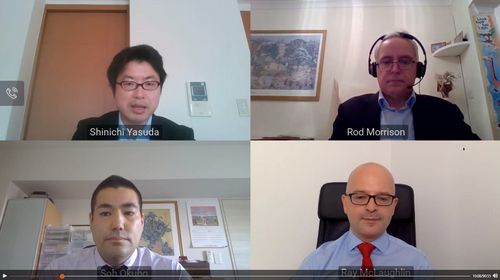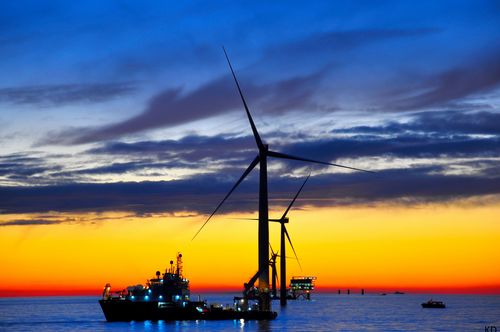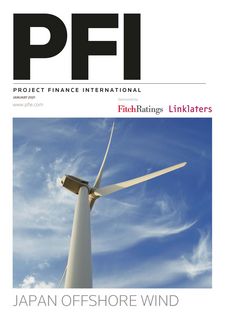Rod Morrison: I’ve just listened to what you’re saying, Manabe-san, about curtailment risk. What sort of solutions do you think, and maybe ask Taba-san as well, what sort of solutions do you think are possible? Is it just a question of working with the authorities and working through these problems, or are there fixed solutions you think that may be applicable?
Takehisa Manabe: It’s a good question. For the time being, I think in terms of risk assessment, we have to rely on the utilities’ development of transmission lines to enhance capacity and transfer electricity from the northern part of Japan to Tokyo. We need to assume that, as a base case, they can achieve what is required. So, we need to include such a simulation in our worst-case scenario and take that into account in terms of the financing.
I think we have two transactions in the northern part of Japan in the first round and three more in the second round of the bidding. In the process of arranging financing for these projects, banks need to understand the curtailment risk and, together with the market consultant in Japan, have a deeper understanding of the risk.
Hirofumi Taba: I think the new legislation that I mentioned also contemplates an upgrade of the national grid on an integrated basis. I think it’s on the regulatory and policy agenda, but it will take time to get through. At the moment, I think the idea is for the regional utilities to make their own attempts to improve transmission. But there really needs to be a nationwide effort in drawing up a master plan to evaluate how to upgrade cross-regional transmissions.
Rod Morrison: Great. Thanks, Taba-san. And moving on to Ray McLaughlin to talk from the developer’s point of view.
Ray McLaughlin: From an opportunity perspective, just look at some of the high-level commitments that have been publicly issued and, indeed, Prime Minister Suga’s 2050 net-zero commitment. It’s a big target. Daniel mentioned the 330GW capacity at the moment and if we take at least half of that generation between thermal, coal and gas mix, then about 150 gigawatts over a 30-year period seems reasonable. The 10GW between now and 2030 again, is a great opportunity, but the fact that we have the seventh largest or longest shoreline in the world, you would think that ramping up the capacity of offshore wind would be relatively easy.
And in respect to the challenges that I think that we will encounter as developers, the move to the feed-in premium so soon in the process is one. I think finding a balance is going to be difficult because it exposes project developers and owners to merchant risk.
If we look at the cost of these projects, as highlighted by Daniel, and with the levelized cost of energy in the country, whether it be coal, thermo, as low as US$56 a megawatt or as high as US$84 at present, that’s a target that the merchant generator market is going to find challenging. It’s going to be challenging for renewable developers to bid so low when there is uncertainty on what the renewable premium is going to be, because you’re not guaranteed to have the dispatch unless you win the par in the merchant market initially. I’m hesitant to say, in respect to the current regime, whether it’s something that is going to be for or against the developers who are looking at five to 10-year development timelines, but obviously it’s finding that balance; price versus net zero goals.
One of the other opportunities I think we’ll definitely see come to the fore is the big energy transition debate and the extensive expertise that sits within Japan and its large zaibatsus in the oil and gas space. I expect to see something not too dissimilar to what’s been happening in the UK and the North Sea, where a large part of Aberdeen recreated itself and transitioned to the renewable markets. I think we will see something similar occur in the Japanese market.
And that’s very exciting because one of the challenges in the market at this time is skillset, or rather the lack of skillset, from a development perspective, from a legislative reform perspective and from the financing and insurance perspective. So, bringing each of those key components and key verticals on the journey as the market evolves from the feed-in tariff to the feed-in premium is going to be one that will definitely be watched closely.
Rod Morrison: It may be totally unfair to ask you a question from the audience saying, “At what level of tariff would these projects be profitable?” I don’t know if you could possibly . . .
Ray McLaughlin: Good question. As high a tariff as possible. It’s unknown, really, but to reiterate the fact that the feed-in premium starting in April 2022 is a merchant market, we, as developers or owners of renewable energy assets, would have to bid in against the incumbent, thermal, coal, gas, even solar.
That is sitting at an LCOE as low as US$70 a megawatt-hour (MWh) at the moment. And yes, there is no firm power solution without both wind, storage and solar if we’re looking at a net zero scenario, but that is further out.
There’s also the issue that Daniel talked about: the Japanese market being seven times bigger than Taiwan. But, in some cases, the wind speeds are going to be lower than a lot of us are used to, maybe in Taiwan or North Sea UK. So, it’s finding a balance and finding the cleaner wind zones that may drive the offshore wind market to its over I,000GW of potential.
But it’s how the industry will evolve to draw the surplus energy and transition to other markets such as the green hydrogen revolution where we’re looking at growing the capacity of generation to be utilised in other sectors.

Rod Morrison: Insurance is obviously one of the key topics in offshore wind. So, we’re lucky to have Okubo-san from Tokio Marine, if you’d like to talk about the opportunities and challenges.
Soh Okubo: Yes. I believe that most of the knowledge, including in the insurance industry, came from the offshore oil and gas energy industry. So, the biggest challenge we face in Japan is that we didn’t have any large oil field nearby from which to draw experience. All of the suppliers and all the contractors have no experience of doing a huge offshore development on things like oil and gas, so I think that’s one of the biggest challenges we’re facing.
But we do have experience globally, where we are underwriting about 45 projects mostly in Europe and seven in Taiwan. And what we are seeing is that almost all CAR losses (construction all risks insurance) are suffered in losses from cables.
That makes us believe that, from the insurer’s perspective, the biggest risk in the Japanese market will be cable loss. That may be a challenge. The difference between the European market and Japan is that the cable layer, the laying vessel, is owned by the cable manufacturer in Japan. So, there might be some advantage there. But, at the same time, they don’t have any experience at this moment of laying offshore wind cables. What we saw in the European market was huge amounts of confidence on the cables issue. They were so confident that they could lay cables without any issues. They thought it was a piece of cake. But what occurred was totally different. It was a totally different kind of construction process for them and we saw a lot of losses coming in. So initially, when the industry started, the insurance cost for the construction was something around 3%. Then, as the industry gained experience, and many other insurers came in, prices went down by 2% to 1%. And then all the losses came in. So, at this moment, we are facing a market going through a hardening stage, with prices going through the roof, almost doubling in maybe the last eight months. So, what we’re actually expecting is that when the Japanese market opens up, there might be a time when it is very difficult to purchase insurance.
Another thing I have to mention, and one of the biggest differences for Japan, I believe, is natural catastrophe risks - earthquakes and also typhoons. We see these issues in Taiwan as well, but in Taiwan the risk is more concentrated in the western part of Taiwan. In Japan, it’s a little bit more spread apart, so we might have some issues in terms of purchasing insurance against NatCat risk.
Rod Morrison: Okubo-san, you mentioned about the losses in the cables. What do you see the Japanese contractors can do in this new market to mitigate that risk? Are there any localised solutions they can be used to mitigate the potential losses we’ve seen elsewhere?
Soh Okubo: I don’t think that kind of issue will occur too frequently because, as you know, all the early developments will be quite close to the shore, which means they won’t need the same type of export cables as in the European fields. Most of the cable laying is done with thinner cable, which means that it is a lot easier than in the European market. I think that’s a positive point, but a negative point is that there is a lack of cable laying vessels in Japan. So, if there are any issues with one vessel, it might be very difficult to arrange another to come to Japan. And, unlike in the European market, we have to have Japanese-flagged vessels to lay cables in Japanese waters.
Rod Morrison: Yasuda-san, what opportunities and challenges do you see?
Shinichi Yasuda: In the Japanese offshore wind power market, there is currently only one fixed-bottom commercial project, which is Marubeni’s Akita project but, as was mentioned by Taba-san, METI and MLTI are very aggressively trying to reduce the generation cost in the future. I think a key development discussed by DBJ and other regulatory parties is the possibility of share transfers. As part of the bidding process in the Japanese offshore wind power market, you will find regulatory articles that allow for a share transfer of less than one-third of the equity during the construction period, and either equal to or less than one half, 50%, of the equity after completion.
I think why this article is involved in the bidding process is that METI an MLTI understand that capital recycling for the equity portion can contribute to a reduction in the cost of the project. It allows for the capital gain to go to the original developer. Also, debt leverage is very important and this impacts on the potential for equity liquidation. Liquidity is very important.
In Japan, even for the solar sector, institutional investors typically don’t like construction risk. Therefore, it might be difficult to find Japanese institutional investors to take on construction risk for offshore wind power projects, so I think it will need foreign investors in Japan, foreign institutional investors and, of course, some Japanese investors, including DBJ and other financial groups, to contribute. This makes the capital recycling regulations important as it allows more players to come in at different stages. That’s what made them include the articles, I think.
And, as mentioned by other panellists, there are some uncertainties around systemic risks, either at the government level, or curtailment risks and transmission risks by which I mean that payment for transmission usage charged to the developers (wheeling charge) might increase. Discussions have been ongoing with the government about this for one or two years already but there is still uncertainty as to how much the developer will need to pay to use the transmission lines.
Other than that, I think it can be clearly seen from the messages coming out from all sides of the market and from the cabinet side that they are very clear in their support for renewable energy. I think that’s a very good thing for everyone. We just have to be very patient.
Rod Morrison: Thank you, Yasuda-san. I guess that’s an opportunity to move onto the second part of our discussion, which is on financing these projects. I’ll ask Taba-san about what unique financing structures the Japanese market will see.
But we had one question, Taba-san, from the audience about what other risks there are with utilities on the PPA. Maybe you could deal with that very quickly before moving on to your thoughts on financing the projects. What are the largest issues in terms of the PPA with the utilities, other than the curtailment risk.

Hirofumi Taba: The PPA, I don’t expect anything different from other renewable projects, like solar. In other words, it’s a developed market model, so there are no political risks or force majeure protections. So, I think it’s all project risk. No different from solar or projects in other renewables transactions.
Rod Morrison: Your thoughts on the financing of these projects, please.
Hirofumi Taba: So, the financing. There are no marks allocated in the auctions, but financing is important. It plays an important part in the feasibility evaluation. If the financing plan is not feasible, then you’re automatically disqualified. But, I think, after taking on feedback from market participants, there is some flexibility. Previous versions of the auction guidelines seemed to anticipate project financing at the project company level. But taking on some feedback, I think it is expected that bidders can propose a structure where part of it uses different types of financing such as corporate finance, equity finance, etc but in that case, obviously you would need to demonstrate how you’re going to procure the funding.
I think it’s a positive sign that there is some flexibility on the bidder side to propose a financing plan. Once the financing plan is ready and proposed, it will become binding in a way that if you want to change it you will need to get consent from MITE and MLIT. So, I think probably, during this period, the bid period, there is a lot to do for the bidders to come up with a financing plan.
To see the digital version of this roundtable, please click here
To purchase printed copies or a PDF of this report, please email gloria.balbastro@refinitiv.com
